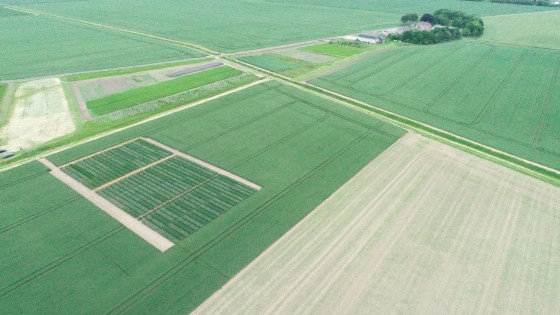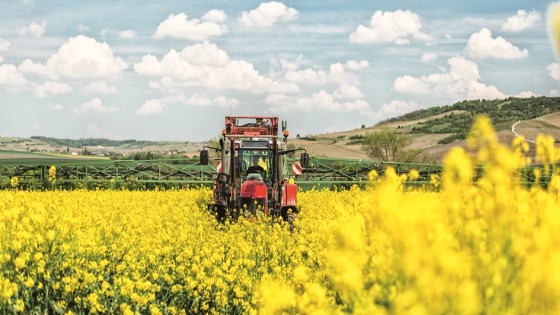Biodiversity
Managing for crops and biodiversity on our sustainability farms
BASF has partnered with two profitable and passionate family farming businesses since 2002 to demonstrate how farms can implement practical wildlife enhancing measures to support biodiversity, whilst maintaining and enhancing the highly productive areas of the farm.
Located in the East Riding of Yorkshire and the Northamptonshire Clay belt, they operate in very different landscapes, but both show strong practical control of costs and performance, alongside the delivery of a wide range of biodiversity and sustainability resources, required by both government and the public.
The farm at Rawcliffe Bridge
At first glance the Hinchliffe’s 350-acre farm near Goole in East Yorkshire looks like the efficient, productive, flat arable farm that it is, sitting on top of 45cm of alluvial soil that came from intentional flooding of the fields from the adjacent Dutch River between 1820 and 1850.
Crops are established using the latest technology “no-till” drills to encourage healthy soils full of earthworms and organic matter, crop production inputs are applied with GPS accuracy to 1cm and fuel-efficient combine harvesters fill the barns with the wheat and oilseed rape that goes into making the food we eat.

More than just a farm
But take a moment to stop, look and listen and you will also discover a vibrant farmed landscape full of birds and bird song, pollinating insect like bumblebees taking a drink from nectar rich flowering strips, moths and butterflies hanging around the oak woodland and native plants like vetches and tall grasses filling the uncropped field corners. The farm is alive and demonstrates a “whole-farm” sustainable balance between safe intensive farming and effective wildlife management.
BASF has partnered with the farm since 2002 to implement practical wildlife enhancing measures to encourage biodiversity and has supported intensive, independent monitoring of the species and habitats that use Rawcliffe Bridge as their home. Including the most recent survey in 2016, 111 bird species have now been recorded at Rawcliffe Bridge, with 63 of them holding breeding territory at the farm. When you add in the 22 species of butterfly, 120 species of moth and six different bumblebee species and 64 plant species in the farms numerous ditches, you soon come to realise that productive farmland supports a lot of important biodiversity along with all the other bugs and beasties in the soil in the fields and on the ditch sides.
Improving biodiversity is just one of the objectives at Rawcliffe Bridge, alongside demonstrating best practice techniques to farmers, regulators, politicians, researchers and other visitors from around the world in an open, transparent approach.
Situated near the sleepy hamlet of Mears Ashby, The Grange is hidden amongst rolling hillside, diverse tall hedges and broad-leaved woodlands. Owned by the Pitts family for over half a century, the same goals and aspirations to deliver safe, affordable food alongside a thriving healthy environment drive the business forward.
Crop rotations are organised to deliver natural pest and disease control, while promoting high soil health across the many soil types found on the 2000 acres of farmed land. Although much of the farm is on long-term tenancies, the attention to detail is maintained to produce high yielding crops in fields surrounded and connected by sown margins and areas for farmland birds and pollinators. The government’s Higher Level Scheme (HLS) provides the opportunity to substitute crop production for delivery of environmental resources, such as seeds for small birds in winter and nectar-rich plants in summer that help bumblebees and solitary bees expand their home territories.
The Grange has been part of the BASF European Farm Network since 2009 and has hosted numerous events where water companies, government officials, environmental organisations and farmers have come together to communicate and discuss farming and environmental issues. Perhaps more importantly they share the knowledge gained about the sustainable farming that takes place at the Grange, to a much wider audience when they leave.
The extensive biodiversity data gathered on the farm from 2009 has been integrated with habitat and crop production data to drive forward a better understanding of the balance between food production and healthy farmland. This has lead to further work in 2017 and beyond, demonstrating how manage the trade-offs ever present in farming.
The species numbers found at The Grange are very similar to those recorded at Rawcliffe Bridge, providing further independent data to support the successful sustainability approaches adopted at both farms. Including the most recent survey in 2016, 81 bird species have now been recorded at The Grange, with 61 of them holding breeding territory at the farm.
Optimum soil management is a cornerstone of the arable cropping systems at the farm, with annual comparisons made of different establishment systems being undertaken to ensure the soils are cultivated and fed in the best way to support healthy soil ecosystems, which in turn drive profitable crop production.


